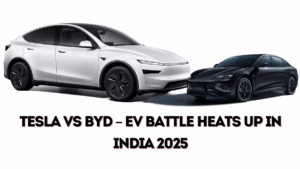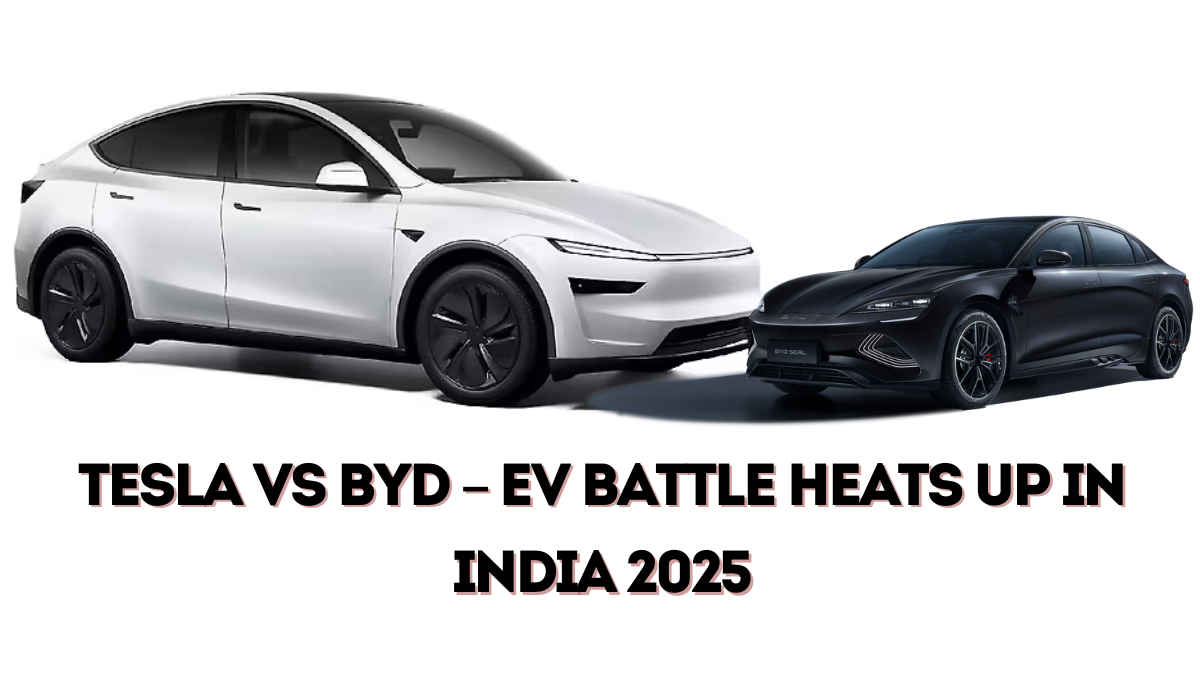The Indian automobile industry is undergoing a historic shift as two global electric vehicle giants, Tesla and BYD, intensify their rivalry on Indian soil. With both companies targeting the fast-growing Indian EV market in September 2025, the competition has become one of the most closely watched developments in the auto world.

Why India Is the New Battleground
India is currently the third-largest automobile market in the world, and its EV segment is projected to grow at over 40% annually until 2030. Rising fuel costs, government subsidies, and stricter emission laws are pushing both automakers and buyers toward electrification.
For Tesla and BYD, India offers:
-
A massive consumer base.
-
Untapped potential in premium and mid-range EVs.
-
A chance to shape the future of sustainable mobility in one of the fastest-growing economies.
Tesla’s Strategy in India
Tesla’s long-awaited entry into India finally became a reality in 2025. After years of negotiations, the company set up its first assembly plant in Gujarat. This move allows Tesla to benefit from reduced import duties while offering competitive pricing.
Models initially introduced include the Tesla Model 3 and Model Y, priced around ₹45 lakh to ₹55 lakh. The cars are being marketed as luxury EVs but with accessible pricing compared to their international versions.
Tesla is also expanding its Supercharger network in India, ensuring urban buyers and inter-city travelers have access to fast charging infrastructure.
BYD’s Counter Strategy
BYD, the Chinese EV giant, already has a head start in India with its Atto 3 SUV and e6 MPV. In 2025, it introduced new models like the BYD Seal, directly challenging Tesla’s sedan dominance.
Unlike Tesla, BYD focuses not only on premium buyers but also on the mid-range EV segment, where Indian customers are more price-sensitive. With pricing starting at ₹35 lakh, BYD has positioned itself as the more value-for-money alternative.
Government Role in the Rivalry
The Indian government has welcomed foreign EV investments while balancing local industry interests. Under the FAME-III scheme and GST 2.0 reforms, EV buyers receive significant tax cuts and subsidies.
However, trade tensions between India and China add complexity to BYD’s expansion. Tesla benefits from stronger diplomatic ties with the United States, giving it a potential edge.
Consumer Sentiment
Indian buyers are excited about both brands. Social media buzz shows younger customers leaning toward Tesla for its tech-driven image and global appeal, while practical buyers prefer BYD for its affordable pricing and spacious designs.
Showrooms in cities like Delhi, Mumbai, and Bengaluru are already seeing strong interest in both brands, with booking numbers climbing steadily.
Key Differences Between Tesla and BYD in India
| Feature | Tesla | BYD |
|---|---|---|
| Market Entry | 2025 | 2021 |
| Focus Models | Model 3, Model Y | Atto 3, e6, Seal |
| Price Range | ₹45–55 lakh | ₹35–45 lakh |
| Charging Network | Tesla Superchargers | Tied with Indian charging firms |
| Brand Image | Tech luxury | Value + practicality |
| Local Assembly | Gujarat | Chennai (partnership with Megha Engineering) |
This comparison highlights how Tesla focuses on luxury and tech superiority, while BYD appeals to value-driven customers.
Challenges Ahead
Despite the excitement, both brands face major challenges:
-
High Competition: Tata, Mahindra, Hyundai, and MG already dominate India’s EV landscape.
-
Charging Infrastructure: Rapid network expansion is needed to match growing EV sales.
-
Geopolitics: BYD’s Chinese origin may affect its perception and regulatory approvals.
-
After-Sales Service: Both companies must ensure nationwide support to win long-term trust.
Industry Experts’ View
Auto analysts suggest that India’s EV market is large enough for both Tesla and BYD to thrive. Tesla will likely dominate the premium EV segment, while BYD captures the mid-range and fleet market.
Some experts even believe their rivalry will accelerate EV adoption, benefiting local players by increasing overall awareness and infrastructure.
Impact on Local Carmakers
Tata Motors, currently the leader in India’s EV sales, is preparing to launch the Punch EV and Harrier EV to maintain dominance. Mahindra is also set to roll out its Born Electric range.
The presence of Tesla and BYD raises the bar for Indian automakers, forcing them to upgrade technology, safety, and range features. In the long run, Indian buyers will benefit the most.
Final Thoughts
The Tesla vs BYD battle in India is more than just a rivalry between two global giants. It represents a turning point for India’s auto industry, pushing the nation toward faster EV adoption.
Tesla brings global brand power, cutting-edge technology, and a strong charging ecosystem. BYD offers affordability, practicality, and early mover advantage. Together, they are set to reshape the way India looks at mobility.
For consumers, 2025 marks the start of a golden era of electric choices, where luxury, affordability, and sustainability come together on Indian roads.
FAQs
When did Tesla officially enter India?
Tesla entered in 2025, starting with local assembly in Gujarat.
Which BYD models are available in India in 2025?
BYD offers the Atto 3, e6, and the newly launched Seal sedan.
Which is cheaper, Tesla or BYD in India?
BYD models start around ₹35 lakh, while Tesla’s entry-level Model 3 costs about ₹45 lakh.
Who has a better charging network?
Tesla has its Supercharger network, while BYD partners with Indian charging providers.
Will this rivalry benefit Indian buyers?
Yes, it will lead to better prices, more options, and faster charging infrastructure growth.
Click here to know more.
